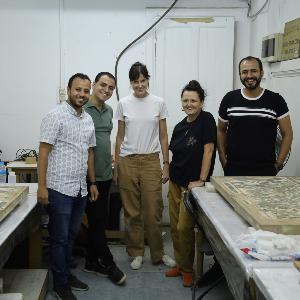Bird nests for the pharaoh
6 Oct 2025
Egyptologist Martina Ullmann studies painted fragments from the Malkata Palace of Amenhotep III.
6 Oct 2025
Egyptologist Martina Ullmann studies painted fragments from the Malkata Palace of Amenhotep III.
When Pharaoh Amenhotep III trod the floors of his palace, it was as if he was walking through a lake. Fish swam under his feet, ducks nested in reeds along the perimeter, and plump cows grazed between papyrus plants on the walls. The colored paintings on floors, walls, and ceilings contributed to the splendor of his royal palace at Malkata in Western Thebes – and presented him as the guarantor of fertility and prosperity.
“Amenhotep III was venerated in the 14th century before Christ as the sacred ruler of Egypt,” explains Martina Ullmann, Professor at LMU’s Institute for Egyptology and Coptology. “The rich painting of his palace was not just decoration. It showed how he ensured the order of the cosmos – and how the country thrived under his rule.”
In a project funded by the American Research Center in Egypt, the Egyptologist and her institute colleague Professor Regine Schulz restored, documented, and analyzed a dozen roughly 3,300-year-old paintings from Malkata. In around the year 1900, archeologists had removed these works from the ruins of the palace and brought them to the Egyptian Museum in Cairo. “These rare examples of palace decoration from the late 18th dynasty afford insights into the pictorial worlds of an advanced civilization,” says Ullmann, “which wove together nature, religion, and politics into the symbolism of a kingdom.”
During the 38-year reign of Amenhotep III, Egypt was at a political and economic highpoint. “In Western Thebes, on the fertile shores of the Nile, the king ordered a palace to be built, which was actually an entire city: with temples, villas for high-ranking officials, workshops, and an artificial lake for ceremonies.”
His role as the sponsor and the object of cult veneration is just as apparent in the palace as in the decoration of his temples.Martina Ullmann
Here, Amenhotep III presented himself in the duality of a pharaoh – as a human who was also venerated as a god. At the magnificent Sed festival, for example, his vitality and ability to rule were renewed according to ancient tradition. “His role as the sponsor and the object of cult veneration is just as apparent in the palace as in the decoration of his temples,” explains Ullmann. “Accordingly, the marsh with the ducks, nests, and fish stood for the fertility and renewal which the country was experiencing under the pharaoh. Cows symbolized a secure food supply, sacrificial offerings, and the prosperity of the kingdom.”
One fragment is ornamented with bovine heads and rosettes, or ‘bucrania’ as they are known. These motifs referred to the connectedness of the pharaoh with the cosmos, the primordial ocean, and the stars, which in turn stood for the constant renewal of the world. At the center of this cosmic order was Amenhotep III, responsible for the daily rising of the sun as living sun god on Earth.
But also in his capacity as temporal ruler, he left no doubt as to his strength, including in the imagery he used. On the floors and steps in the throne room of Malkata, there were depictions of bound Syrians and Nubians, enemies of Egypt at the time, with typical garments and hair ornaments. Whenever the king crossed the room to ascend his throne, he would inevitably step on these figures.

The Malqata team, with Bianca Madden (Oxford) in the middle next to Martina Ullmann (third and second from the right), in the laboratory in Cairo. | © Malqata Project
Restoration of the fragments, which are thousands of years old, was no easy task for the German-Egyptian team. Many pieces had been stored in the museum for over a hundred years and were mounted behind glass, their colors darkened and scarcely recognizable. Some of the large painted fragments are also extremely heavy, because when they were removed in the early 20th century, they were fixed to a clay substrate with metal grating in the interior.
First of all, Ullmann’s team cleaned and carefully firmed up the crumbling clay layers. Then they used modern technologies such as UV and X-ray light and pigment analyses to reveal details that had long been hidden.
For example, the plumage of the birds on the ceilings stood out more clearly. For whole flocks of birds to flap their wings in a wild jumble was unusual for Egyptian art of this era. “Until then, Egyptian painters had mostly depicted individual birds in a style that was less lively and true to nature.” As such, the fragments are of particular art historical interest as well.
In the Cairo museum, the painted fragments are now arranged in such a way that you can appreciate their original placement in the palace. You can even visit the long-vanished palace of Amenhotep III, with its magnificent mural paintings, from the comfort of your own home – virtually, in the 3D model of a French Egyptologist.